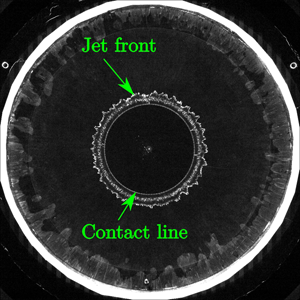Crossref Citations
This article has been cited by the following publications. This list is generated based on data provided by
Crossref.
Hascoët, Romain
Raillard, Nicolas
and
Jacques, Nicolas
2021.
Effect of forward speed on the level-crossing distribution of kinematic variables in multidirectional ocean waves.
Ocean Engineering,
Vol. 235,
Issue. ,
p.
109345.
Chen, Ying
Li, Jie
Gong, Zhaoxin
Chen, Xin
and
Lu, Chuanjing
2021.
LES investigation on cavitating flow structures and loads of water-exiting submerged vehicles using a uniform filter of octree-based grids.
Ocean Engineering,
Vol. 225,
Issue. ,
p.
108811.
Del Buono, A.
Bernardini, G.
Tassin, A.
and
Iafrati, A.
2021.
Water entry and exit of 2D and axisymmetric bodies.
Journal of Fluids and Structures,
Vol. 103,
Issue. ,
p.
103269.
Wang, An
Wong, Kit Pan
Yu, Miao
Kiger, Kenneth T.
and
Duncan, James H.
2022.
The controlled impact of elastic plates on a quiescent water surface.
Journal of Fluid Mechanics,
Vol. 939,
Issue. ,
Hulin, F.
Del Buono, A.
Tassin, A.
Bernardini, G.
and
Iafrati, A.
2022.
Gravity effects in two-dimensional and axisymmetric water impact models.
Journal of Fluid Mechanics,
Vol. 944,
Issue. ,
Gao, Shan
Shi, Yao
Pan, Guang
and
Quan, Xiaobo
2022.
Research on the effect of asymmetric bubbles on the load characteristics of projectiles during an underwater salvo.
Applied Ocean Research,
Vol. 124,
Issue. ,
p.
103212.
Lu, Yujin
Buono, Alessandro Del
Xiao, Tianhang
Iafrati, Alessandro
Deng, Shuanghou
and
Xu, Jinfa
2022.
On applicability of von Karman’s momentum theory in predicting the water entry load of V-shaped structures with varying initial velocity.
Ocean Engineering,
Vol. 262,
Issue. ,
p.
112249.
Zan, Yingfei
Qi, Baowen
Ding, Song
Guo, Ruinan
Wang, Yong
and
Li, Baozhong
2023.
Experimental and Numerical Investigation of Cavity Structure Forced Water Exit from Calm Water at Constant Lifting Velocity.
Journal of Marine Science and Engineering,
Vol. 11,
Issue. 2,
p.
274.
Zhi, Mingyang
Li, Zhipeng
Sun, Longquan
and
Wang, Duliang
2023.
Investigation and optimization of load characteristics of a multi-stage load-reduction structure for vehicles during high-speed vertical water entry.
Ocean Engineering,
Vol. 289,
Issue. ,
p.
116183.
Li, Xueyi
and
Zheng, Feidong
2023.
Investigation into the Water Exit Behavior of a Cavity.
Sustainability,
Vol. 15,
Issue. 2,
p.
1007.
Lu, Yujin
Del Buono, Alessandro
Xiao, Tianhang
Iafrati, Alessandro
Xu, Jinfa
Deng, Shuanghou
and
Chen, Jichang
2023.
Parametric study on the water impacting of a free-falling symmetric wedge based on the extended von Karman’s momentum theory.
Ocean Engineering,
Vol. 271,
Issue. ,
p.
113773.
2023.
Numerical investigation on cavity dynamics of water-entry bodies with different shape parameters.
Physics of Fluids,
Vol. 35,
Issue. 6,
Goron, M.
Langrand, B.
Jacques, N.
Fourest, T.
Tassin, A.
Robert, A.
and
Chauveheid, D.
2023.
Simulation of water entry–exit problems highlighting suction phenomena by coupled Eulerian–Lagrangian approach.
European Journal of Mechanics - B/Fluids,
Vol. 100,
Issue. ,
p.
37.
Gao, Shan
Shi, Yao
Pan, Guang
Quan, Xiaobo
and
Yu, Yilan
2024.
An investigation on the wake vortex structure and trajectory characteristics of the vehicle launched underwater.
Ships and Offshore Structures,
Vol. 19,
Issue. 7,
p.
911.
Yun, Honglu
Liu, Qingbo
Zeng, Zheng
and
Lian, Lian
2024.
Experimental study on water-exit of cylinder.
Ocean Engineering,
Vol. 293,
Issue. ,
p.
116585.
Zhang, Guiyong
Liang, Guangqi
Yang, Xi
and
Zhang, Zhifan
2024.
Numerical investigations on water entry and/or exit problems using a multi-resolution Delta-plus-SPH model with TIC.
Ocean Engineering,
Vol. 292,
Issue. ,
p.
116560.
Tassin, Alan
Hulin, Florian
and
Jacques, Nicolas
2024.
A direct multimode method for the reduction of vibration induced oscillations on force signals during “pseudo-rigid” water impact experiments.
Journal of Sound and Vibration,
Vol. 581,
Issue. ,
p.
118378.
Zheng, Hualin
Qiang, Hongfu
Zhu, Yujie
and
Zhang, Chi
2024.
Overview of Theory, Simulation, and Experiment of the Water Exit Problem.
Journal of Marine Science and Engineering,
Vol. 12,
Issue. 10,
p.
1764.
Suh, I. D.
Go, S. C.
and
Rhee, S. H.
2024.
Water entry of a sphere moving along a circular path at a constant speed.
Physics of Fluids,
Vol. 36,
Issue. 7,
Li, Shao-Bo
Ming, Fu-Ren
Peng, Tong-Shuai
and
Sui, Yu-Tong
2024.
Experimental study on the elastic response characteristics of a rotating body under an oblique water impact load.
Ocean Engineering,
Vol. 310,
Issue. ,
p.
118643.




